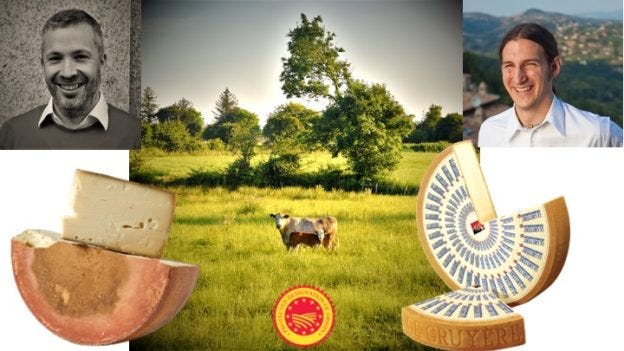Legislating Terroir
A cheesy story? Or legitimate use of geographical indicator as intellectual property?
A federal judge in the U.S. District Court for the Eastern District of Virginia recently ruled that Gruyère cheese was not exclusive to the Swiss French border region, because the term had become generic in the United States. Cheesemakers in Switzerland and France claimed that gruyère could only be made in the Gruyère region of Switzerland and France.1 According to U.S. District Judge T.S. Ellis, “It is clear from the record that the term gruyere may have in the past referred exclusively to cheese from Switzerland and France. However, decades of importation, production, and sale of cheese labeled gruyere produced outside the Gruyère region of Switzerland and France have eroded the meaning of that term and rendered it generic.”
This decision granted American cheesemakers the freedom to name their cheese products Gruyère. Fierce debates about legal protections afforded to geographical origins, production methods, taste, and legitimacy ensued. At a recent “Kitchen Table” gathering, the good folks at the OFS delved into this debate with pundits from both sides of the issue. Below are snippets of that discussion, as moderated by David Matchett. Reporting and associated works by the speakers and other subject matter experts are included.
Shane Holland is the Executive Chairman of Slow Food in the UK, an organisation which seeks Good, Clean and Fair food for all. A significant part of Holland’s work is the Ark of Taste program, which seeks to capture and preserve the culinary and cultural heritage of some of our most endangered foods.
Zachary Nowak received his PhD in American Studies from Harvard University. Nowak is a scholar of the natural and built environments with an emphasis on the nineteenth-century United States. He also helped start The Umbra Institute’s Center for Food & Sustainability Studies in Perugia, Italy. Nowak currently lectures at Harvard University. He is an accomplished instructor prepared to teach global history, U.S. history surveys, historical methods courses, and courses in the environmental humanities and food studies.
On the definition of terroir
Nowak
Terroir is mostly “malarkey”, as my grandmother would say. For me, it’s sort of like the horoscope or the tooth fairy, as far as being “real” in the Real World. People can take it really seriously and it can have real world effects, just like the tooth fairy or the horoscope. I don’t think you can have this idea of terroir, where there’s this geological connection + traditions in a delimited area (that’s very specifically delimited by legislation). And within this certain area, you can make something that has a certain taste, and has always had that certain taste. And outside of this area, no one can reproduce this taste. I don’t believe that you can make cheese at 40 meters above sea level right inside the city limits of Parma and then make the exact same cheese at 1,000 feet up in the Apennine mountains in completely different soil and forage. If you look at most of these PDO (Protected Designation of Origin) areas, you find the same thing. Speaking as a historian too, I don’t think many of the things we eat today tastes like they did even 50 years ago. …
I want to throw some more gasoline on this fire. The job of a oenologist is to largely obliterate terroir. For most wines, the oenologist’s job is to smooth out or eliminate terroir, and make a wine that tastes the same every single year. I love reading papers about wines (and cheese) where two different wines are compared and yet in the end, only trained experts can taste the difference. Honestly, I think many of us (and I know I’m going to get stoned here) would not be able to taste the difference in a blind tasting. Only when we look at the label, can we taste a difference. But when we don’t look at the label, can we really? And if only 1% of us can taste the difference, is that truly a difference? There’s a lot of class hierarchy built into this discussion. It’s not just purely traditions and geology.
Holland
Terroir is about a sense of place and much of the work that I do, defines things which share common boundaries. I'm not saying that things must taste absolutely identical. The likelihood of getting one farm to produce a product similar to the farm next-door is near nil, but we can get things which will taste very similar and have some very special commonalities to them. Perhaps similarities in altitude, weather, humidity, topography, the amount of minerals in the soil … I do believe that you can actually get a general sense of terroir from that. I’m going to say, “yes”, terroir does exist and we can find examples of terroir. However, I do believe that we need to start uncoupling what those protected logos are actually for, from the actual sense of terroir. Many of those logos are actually about business and quantities and selling those items. We often see very popular products coming from areas that get extended and not being extended [geographical protection] because suddenly the weather or the soil has changed.
Earlier this month, a Swiss Gruyère cheese, matured by the Gourmino company based in the canton of Bern, won the World Champion Cheese competition, a biennial event held in Madison, Wisconsin. The cheese also earned the World Champion title in 2020 and 2008.





At a time when everything from hair braids to slang constitutes an act of cultural appropriation or microagression, it seems ludicrous to think that cheese made from anywhere other than the Gruyère region of Switzerland and France can be labeled Gruyère. Thanks for the links and downloads, super helpful.